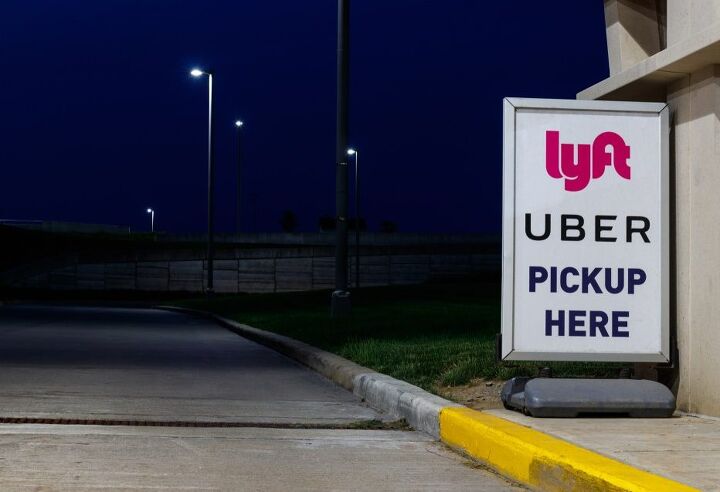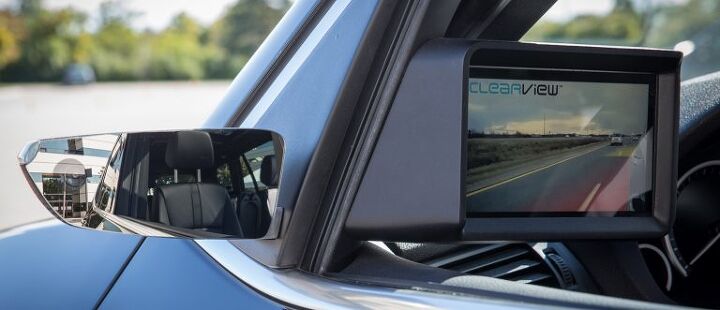#AutomotiveSafety
Lyft Follows Uber, Promises to Prioritize Rider Safety
At the start of this month, Uber released a safety report in a bid to address concerns surrounding rider welfare. Not to be outdone, its main competitor also took steps to convince the masses that it’s also doing everything within its power to keep customers safe.
Lyft is forming a council of experts to assist the ride-hailing company in revising safety initiatives for riders and drivers. The group will include representatives from the Rape, Abuse & Incest National Network (RAINN), It’s On Us, the National Sheriffs’ Association, the National Association of Women Law Enforcement Executives, and the National Organization of Black Law Enforcement Executives. As with Uber’s report, Lyft is focused on incidents of sexual assault — and blaming society for any problems it may have.
It's a Slow Road to Rear-view Video, but Magna Says It's Ready
Even though automakers routinely preview concept and prototype vehicles with camera mounts replacing traditional side and rear-view mirrors, you’ll have to wait a while before the technology makes its way to production vehicles. While Japan thinks ditching mirrors for a digital display is sugoi (Japanese for hunky-dory), other nations have maintained some amount of trepidation in embracing the technology.
For our purposes, both Canada and the United States have examined the matter, yet neither feels ready to make any industry-altering decisions. Supplier Magna International says that’s okay — it’ll be ready to hook up North America with the applicable hardware when the time comes. Plenty of downsides can be found in swapping out traditional mirrors, offsetting some of the benefits, and lawmakers need to figure out how to manage that when it comes time to redefine automotive regulations.
Newly Released Uber Safety Report Focuses On Sexual Misconduct, Murder
Uber released its first safety report on Saturday, primarily to address concerns surrounding rider welfare. The media has become increasingly critical of Uber as a brand after its corporate culture was dubbed toxic — allegedly loaded with sexism and financial progress by any means necessary. Following a fatal accident involving one of the company’s autonomous test vehicles, many grew fearful that the company hadn’t fallen into the habit of promoting (or appreciating) public safety. Hoping to assuage some of those concerns, Uber put together its own safety report.
Earlier in the month, the ride-hailing service said it had received reports of 3,045 sexual assaults in the United States in 2018, with 9 people murdered (nearly half of them drivers… fortunately?) and 58 crash-related deaths. Uber said these issues only affected 0.0002 percent of the 1.3 billion rides the company orchestrated in the United States that year.
The new study attempts to frame data, accumulated over 21 months, against national averages to show that Uber is simply suffering from issues inherent to our society. While noting that an estimated 44 percent of women in the U.S. have been a victim of sexual violence seems like an odd way to absolve oneself from wrongdoing, Uber’s just a fancy cab service trying to distance itself from systemic fears that may have not have been entirely fair.
Another Gigantic Takata Airbag Recall Could Be Incoming
Automakers could be staring down the barrel of another brutally large airbag recall as the National Highway Traffic Safety Administration evaluates the long-term safety of inflators manufactured by the now-bankrupt Takata. Earlier this month, the parts supplier announced a recall affecting 1.4 million additional vehicles following the death of a BMW driver. Several new injuries also stemmed from the issue.
At the same time, the U.S. road safety regulator had to make a decision as to whether the roughly 100 million inflators containing a chemical drying agent intended to solve the problem are actually safe.
So far, it’s looking like a no.
The Takata Recall Continues; Now Includes 1.4 Million Additional Vehicles
The largest automotive recall in history just got a little more inclusive. Takata is recalling another 1.4 million vehicles after the airbag-related death of a BMW driver. The German manufacturer has issued three recalls covering roughly 116,000 U.S. vehicles containing the faulty equipment, saying it is aware of at least one fatality in Australia, plus a few injuries.
By now, you’re probably familiar with the issue. Takata supplied tens of millions of defective air-bag inflators over several years. The units are prone to exploding in the event of a crash, spraying metal shrapnel inside the cabin, after its propellant becomes compromised by nothing more than moisture. This has led to many senseless deaths, the largest automotive recall in history, and Takata declaring bankruptcy two years ago before its purchase by China’s Ningbo Joyson Electronic Corp.
Australia Introduces Phone Detection Cameras for Roads
Australia put up the first phone-detecting cameras in New South Wales over the weekend. The move is part of a broader plan to reduce roadway fatalities by 30 percent by 2021 — especially as new technologies continue to exacerbate the issue of distracted driving. “It’s a system to change the culture,” NSW Police Assistant Commissioner Michael Corboy told Australian media las week.
There’s nothing incredibly new about the cameras themselves. But they’re networked to an artificial intelligence that determines whether or not someone behind the wheel is using their phone. Suspect images are then forwarded to authorized personnel to be verified as truly criminal.
Regulators, Mount Up: NTSB Presses NHTSA for Better Self-driving Safety
While the National Transportation Safety Board’s (NTSB) job isn’t to establish new regulations, it is obligated to enforce the country’s Federal Motor Vehicle Safety Standards while conducting crash investigations and making recommendations to other agencies on ways to improve vehicular safety.
Lately, that job involves telling the National Highway Traffic Safety Administration (NHTSA), an agency that does write those rules, to step up its game on autonomous vehicles.
Last week, the NTSB held a board meeting in Washington D.C. to determine the probable cause of a fatal collision between a self-driving Uber prototype and a pedestrian in March of 2018. While Uber took plenty of heat, the NHTSA also came under fire for prioritizing the advancement of advanced driving technologies over public safety.
IIHS Wants Bigger, Harder Crashes for Its Side Impact Tests
While the Insurance Institute for Highway Safety (IIHS) has gradually evolved its testing procedures since its inception, it has hit the accelerator over the past few years, eager to crash into a new era of knowledge… Alright, so it actually just wanted to assess problematic crash trajectories and headlight safety for insurance companies. Still, they’ve been making meaningful changes in a bid to boost overall safety.
On Thursday, the institute said it plans to continue evolving its crash-test procedures. It claims it’s gotten so good at developing side-impact assessments, “the current side ratings no longer help consumers distinguish among vehicles or point the way toward further improvements.”
The solution? Slam bigger, heavier items into a vehicle’s profile and see what happens.
NTSB: Autonomous Uber Vehicles Crashed 37 Times Before Fatal Accident
The National Transportation Safety Board (NTSB) has disclosed Uber’s autonomous test fleet was involved in 37 crashes over the 18-month period leading up to last year’s fatal accident in Tempe, AZ. Having collected more data than ever, the board plans to meet on November 19th to determine the probable cause and address ongoing safety concerns regarding self-driving vehicles.
Reuters reports that the NTSB plans to issue comprehensive safety recommendations to the industry, as well demand oversight from governmental regulators, in the near future.
Unfortunately, the circumstances surrounding the fatal incident in Arizona are as unique as they are complicated — ditto for most other crashes involving AVs. While Uber’s test mule failed to identify the pedestrian in time, leading to her death, she was also walking her bicycle on a particularly awkward stretch of road. “The system design did not include a consideration for jaywalking pedestrians,” the NTSB said.
Uber Establishes Oversight Board for Self-driving Development
Uber has formed an independent board tasked with overseeing its autonomous vehicle program. As outsiders, they’ll have no official authority within the company. But the six-member group will have direct access to executive years, and will be using them to advise the business on how best to test and deploy new technologies.
Dubbed the Self-Driving Safety and Responsibility Board, the group was formed after one of Uber’s test vehicles struck and killed a pedestrian in March 2018. An external review commissioned by the company following the incident recommended the board’s formation, with support from the NHTSA.
More Evidence Pedestrian Detection Systems Have Some Problems
It hasn’t even been a full month since the American Automobile Association (AAA) released a study showcasing the shortcomings of advanced driving aids and another damning report has come in — this time from the Insurance Institute for Highway Safety (IIHS). While not nearly as bleak as the AAA study, the IIHS research put several models on blast for having lackluster equipment.
The gist appears to be that the quality of pedestrian detection systems varies wildly between models, with the IIHS picking a few winners and losers. That’s important information to have, especially considering automatic braking systems will be standard equipment on all cars by 2022.
U.S. Road Fatalities Declined in 2018
The National Highway Traffic Safety Administration announced Tuesday that American traffic deaths declined for a second year in a row in 2018. Data indicates a 2.4 percent decline in roadway fatalities last year, with bicyclists and pedestrians being the only groups to see risk moving in the wrong direction.
“This is encouraging news, but still far too many perished or were injured, and nearly all crashes are preventable, so much more work remains to be done to make America’s roads safer for everyone,” said U.S. Transportation Secretary Elaine Chao in a statement.
The DOT/NHTSA attributed improving automotive safety systems as the primary reason for the decline in deaths, though some of the metrics included in the report’s breakdown suggest other factors could be at play.
Tapping Into Technology: Congress Considers Terrifying New Solutions for Drunk Driving
U.S. Senators Tom Udall (D-NM) and Rick Scott (R-FL) plan to introduce new legislation forcing automakers to install hardware that would effectively stop intoxicated individuals from operating motor vehicles by the middle of the next decade. The stated goal is to prevent the thousands of fatal crashes stemming from drunk driving each year. It’s similar to a bill introduced by House Representative Debbie Dingell (D-MI), which aims to have advanced DUI prevention devices in all cars by 2024.
While it’s difficult to get bent out of shape over any system that curtails drunk driving, we’ve managed to find a way. As usual, it plays into your author’s ever-growing phobia of surveillance-focused technologies.
NHTSA Seeks Public Input Regarding Cameras Replacing Side Mirrors
While side-mounted camera systems have been approved as an acceptable replacement for mirrors by much of the developed world, the United States has yet to approve their installation. But it’s under consideration via an advanced notice of proposed rulemaking in the federal register.
The National Highway Traffic Safety Administration has been testing the worthiness of these systems and how drivers interact with them vs traditional mirrors. Now it’s looking for hot takes as research continues.
On Thursday, the NHTSA announced it was also opening the door for public comments on the technology. If you care about this at all (yay or nay), it might be worth offering the agency a well-spoken piece of your mind.
Reportedly Terrible: AAA Tests Pedestrian Detection Systems
The paranoid luddites that write for this site have occasionally been accused of being hyper critical of modern-day driving aids. Be it a cursory mention of how a little snow totally flummoxed the systems of an otherwise agreeable review car, the direct addressing of an issue where road salt encouraged a vehicle to attempt to steer itself into a ditch, or one of this author’s many diatribes on how the bulk of this technology doesn’t seem anywhere near market ready, there’s always a couple of exceptional individuals ready to call us backward-looking morons.
While that’s often a correct assessment in other matters, it seems we’ve called this one correctly. The American Automobile Association (AAA) recently tested four sedans from competing manufacturers, running them through a handful of scenarios intended to replicate situations that place pedestrians at extreme risk. Taking into account the above smugness, you can probably imagine how poorly it went.






























Recent Comments